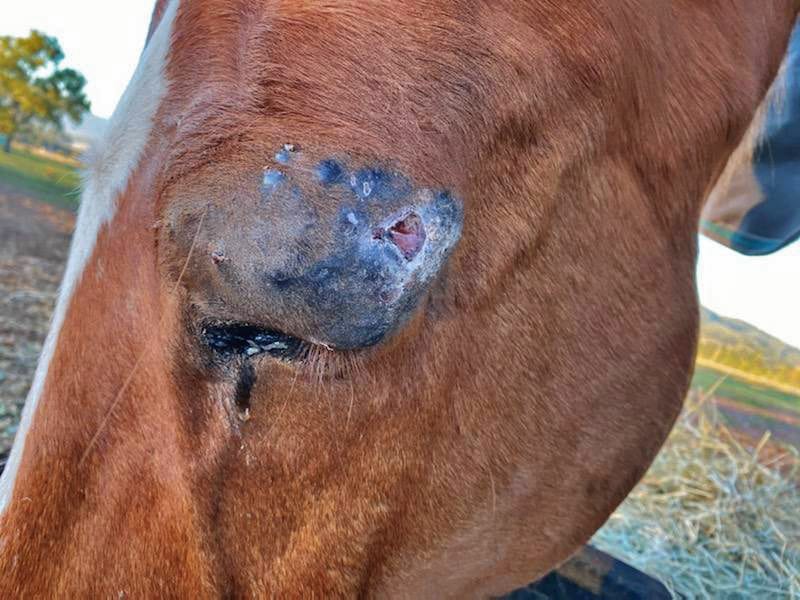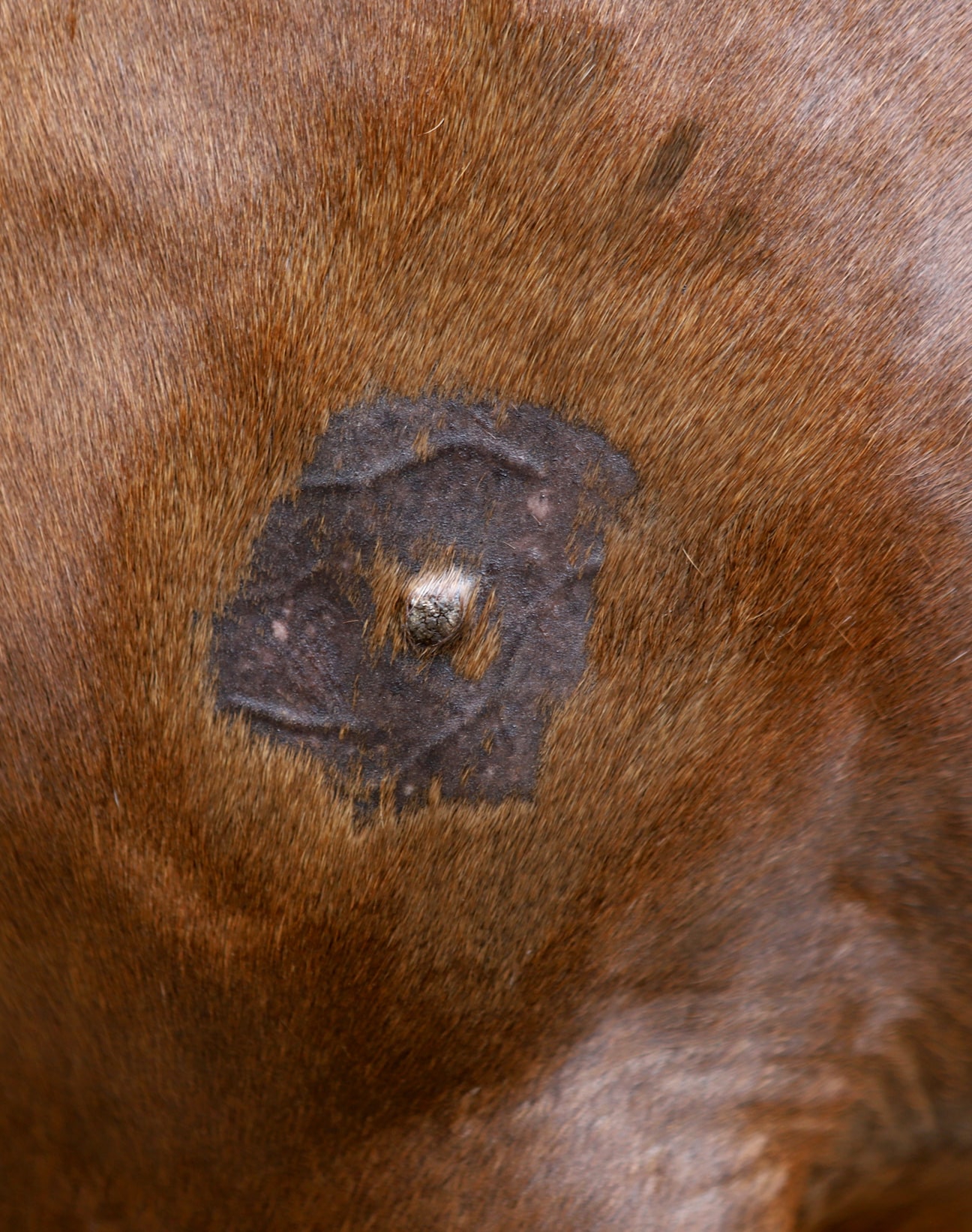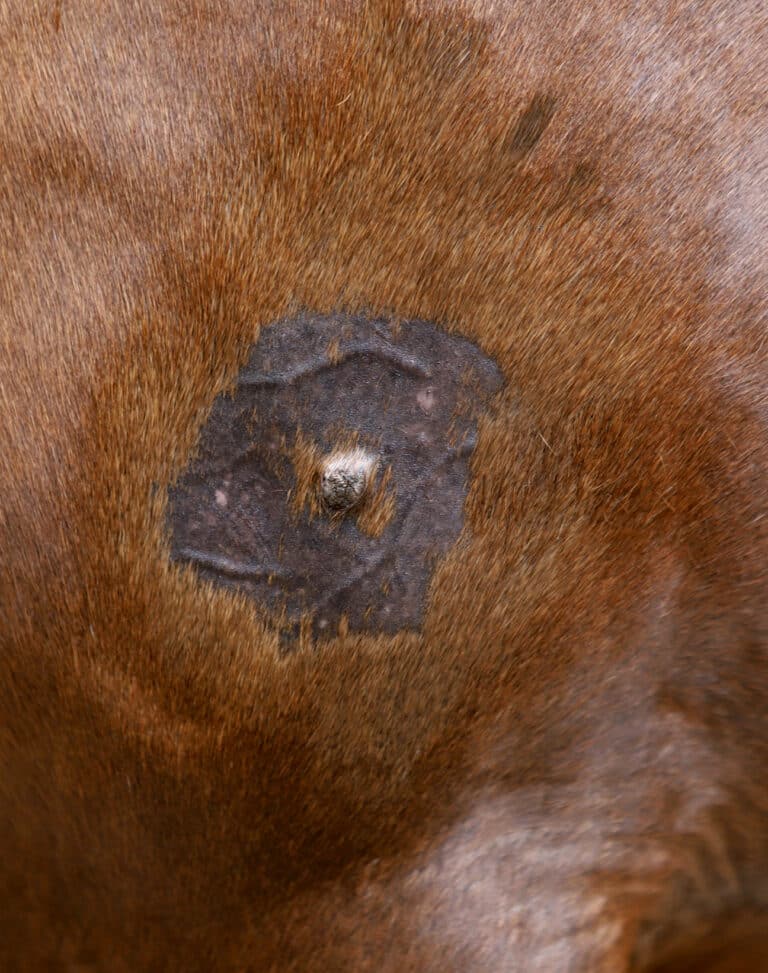
What you should know about sarcoids
Sarcoids, the most common skin tumour in horses, are non-malignant but should not be ignored. The team at HUNTER EQUINE explain.
Sarcoids, the most common type of tumour to affect horses worldwide, develop in the fibrous connective tissues under the skin. A form of skin cancer, they spread locally in the skin and sometimes to tissues beneath the skin. Although they do not spread to internal organs, they can be very invasive and destructive and should not be treated lightly.
Sometimes confused with proud flesh, sarcoids can occur anywhere on the body but the most usual locations are the face, limbs, ar

mpit, belly and groin areas – thin-skinned areas that are commonly traumatised and often the site of fly bites. Areas that have previously been injured are especially vulnerable. Non-healing wounds (particularly those above the knee or hock) should be treated as suspicious and evaluated by your veterinarian. The tumour’s location affects prognosis: sarcoids on the legs and around the eye have a lower chance of resolution and a higher risk of recurrence following treatment.
Sarcoids are more common in younger horses and in certain breeds. For example, Quarter Horses and stock horses are twice as likely as Thoroughbreds to be affected, while Standardbreds are half as likely as Thoroughbreds to develop the tumours. This is suggestive of a genetic or heritable component.
Although thought to be caused by bovine papilloma virus (BPV), a virus which causes warts in cattle, not every horse infected with BPV develops sarcoids. Some evidence, although far from conclusive, suggests BPV is spread by flies, and if combined with trauma and genetic factors, may play a role in the growth of the tumours. However, the virus requires genetically susceptible horses in order for sarcoids to develop, which is why not every horse exposed to the virus suffers from them, while those that are genetically susceptible are likely to keep developing them.
It is possible that sarcoids are spread contagiously, which has worried some people, but as yet, the transmission of sarcoids by either direct horse-to-horse contact or indirectly by flies remains unproven. Although parts of the virus (its DNA and protein) have been detected on flies, the infectious, whole virus has not. Some owners of sarcoid-affected horses have run into difficulties registering them at livery yards because of fears of transmission to other horses. But at present, there is no evidence to suggest that horses with sarcoids are a threat.
Once infected with BPV, it is likely that it will remain with the horse for life – once a sarcoid horse, always a sarcoid horse! As the genetic susceptibility also remains, horses that have been treated for sarcoids often get them again. BPV in horses behaves in a similar way to the papilloma virus (which can cause cervical cancer in women) in people; the virus becomes incorporated into the DNA of infected skin cells and can cause those cells to transform into tumour cells.

Sarcoid subtypes
- Occult: Flat patch of hair loss with a scaly surface. Similar to ringworm. Common on face, neck and between back legs. Earliest and least aggressive form.
- Verrucous: Slow-growing, flat, scaly. Similar to occult but deeper and often more raised than occult tumours. Often appear as multiple lesions.
- Nodular: Firm lumps under unbroken skin. Common around the groin and around the eyes.
- Ulcerative: Large lumps with open, ulcerated wounds. Often have a stalk (pedicle) and are locally very invasive. Can invade into tissues deeper than the skin. Attractive to flies and infestation with maggots is common.
- Mixed tumours: A combination of two or more types of sarcoid forming a colony of tumours.
- Malevolent: Most aggressive type. Infiltrate along fascial planes and blood vessels, grow rapidly and often have ulcerated areas with a high recurrence rate after removal.
Unfortunately, there is no single treatment to cure all sarcoid types, and there is a risk that treatment may actually aggravate the sarcoid, stimulating it to enlarge and become more aggressive and invasive. Diagnosed based on their visual appearance, sarcoids can change subtype, usually after ineffective treatment, and may grow back more aggressively. However, a biopsy to confirm diagnosis of the tumour prior to its removal is usually avoided due to the risk of causing accelerated growth or the worsening of the tumour. Once removed, the tumour can be sent for analysis.
The most important recommendation is to treat them when they are small and manageable. The bigger and more aggressive they become, the more difficult treatment becomes. Spontaneous regression has been documented, although this is very rare and more common in young horses. Get advice from your vet as soon as you notice a sarcoid, no matter how small.
Sarcoid treatments

-
- Surgical excision: There is a 15-82% recurrence rate when used alone, and fronds of the tumour can be missed on excision. At 86%, electrosurgery has the best success rate.
- Laser ablation: The laser vaporizes the tissue as it cuts, resulting in less damage to surrounding tissue and a reduced risk of spreading cancerous cells. Also reduces bleeding, swelling and pain, and depending on the location, size and number of tumours, can be done standing or under general anaesthesia. There’s an 83% success rate when used alone, while combination therapy (chemotherapy, topical treatments or electrochemotherapy) increases success.
- Cryotherapy: The rapid freezing and slow thawing of tissue which kills rapidly dividing tumour cells, while sparing normal cells. The success rate is very variable, and recurrence can be high. Multiple repeat treatments are required, which are slow and time-consuming.
- Radiotherapy: A form of radiation therapy called brachytherapy is very successful. However, limitations include high cost; highly specialised and difficult to access equipment; and its potential danger for patients, personnel and clients. General anaesthesia is usually required.
- Immunotherapy: BCG vaccine stimulates the immune system to eliminate the tumour. More effective for small tumours, tumours around the eyes, and nodular or ulcerative tumours. Local reactions can be very severe, and death from an anaphylactic reaction has been reported.
- Autogenous tumour vaccine: Cryopreserved tumour tissue frozen from liquid nitrogen. Resolved in 68%; reduced in size in 94%; reduced in number 75%. Easy with minimal side effects.
- Chemotherapy: Interferes with DNA copying in cells to prevent tumour cells replicating, and causes cell death. Can damage healthy tissue and should be used with caution over sensitive areas. These drugs cause inflammation, and the area often becomes sore and swollen as the sarcoids regress.
- Cisplatin: injected into the tumour every 2-4 weeks for 4 treatments. Surgical removal of part/all of the tumour is helpful for larger tumours. Variable success rate.
- Imiquimod: Immune modifier with antiviral and antitumour activity. Quite effective in reducing tumour size. A layer applied over sarcoid 2-3 times weekly for 2-4 months. Owners can apply this medication themselves (with gloves) and it can be used over sensitive areas. Severe reactions are not uncommon, and it can cause significant discomfort, making some horses difficult to treat. Clean and dry before application, wash off 8 hours after application.
- AW4-LU (Liverpool Cream): 35% resolution rate reported, but significant scarring. Avoid on tumours close to the eye. Only veterinarians can apply this cream as it contains a chemotherapeutic drug (5-FU) and heavy metals which are dangerous if handled incorrectly.
- Bloodroot (Xxterra cream): There are few controlled studies and it can reportedly make sarcoidssignificantly worse.
- Electrochemotherapy: Chemotherapy drugs with high voltage electric pulses (electroporation). Increases penetration of the drug into cells by around 70 times. 90-100% resolution rates at four years. General anaesthesia required. Multiple treatments may be necessary.
A combination of treatments is recommended, especially with large, aggressive or multiple tumours – and while there are any number of alternative and home remedies available, speak to your veterinarian because irritation of sarcoids can lead to a significant worsening, including their spread or enlargement.
No preventative vaccine is currently available, although protection from flies may help. When purchasing a horse, it’s vital to have your vet examine them carefully for sarcoids, which are likely to interfere with tack in the head or girth area, and if on the legs are liable to be traumatised during exercise. Sarcoids on the udder or in the groin region of a potential broodmare are also a problem, so consider carefully the expense of potential and repeated treatments, including prolonged recovery.



